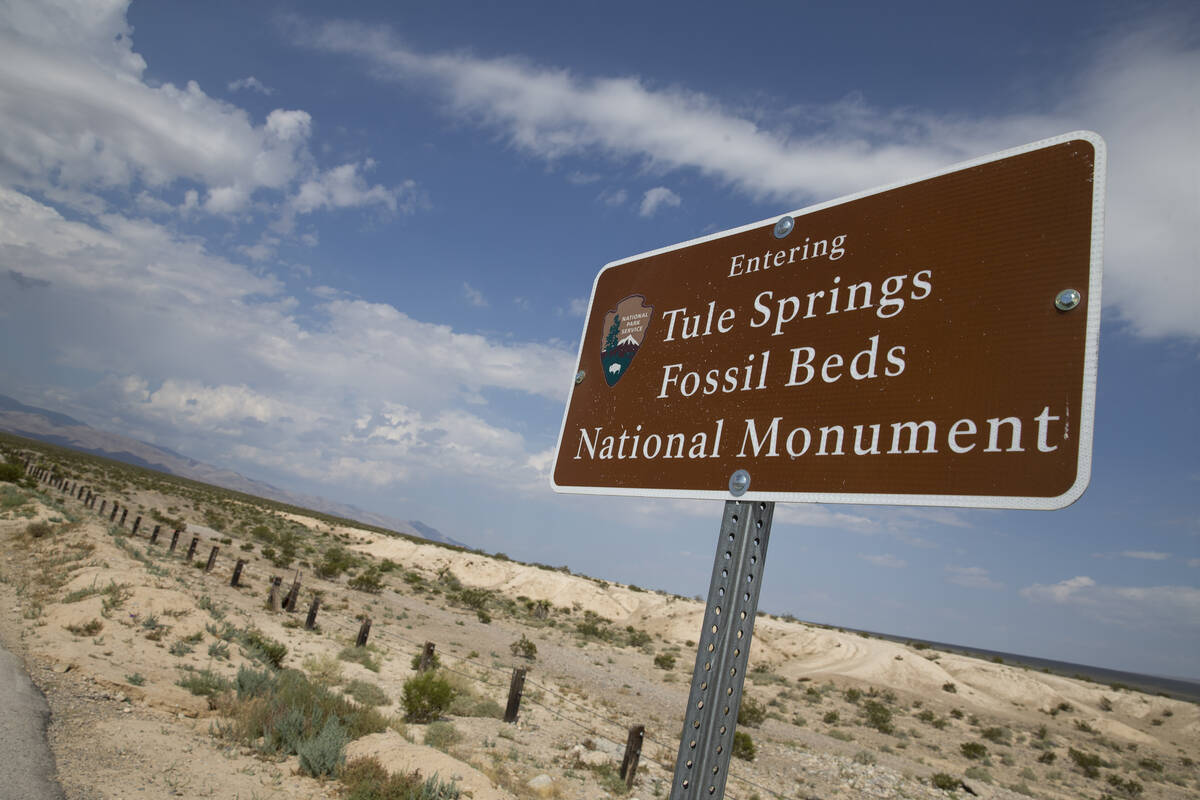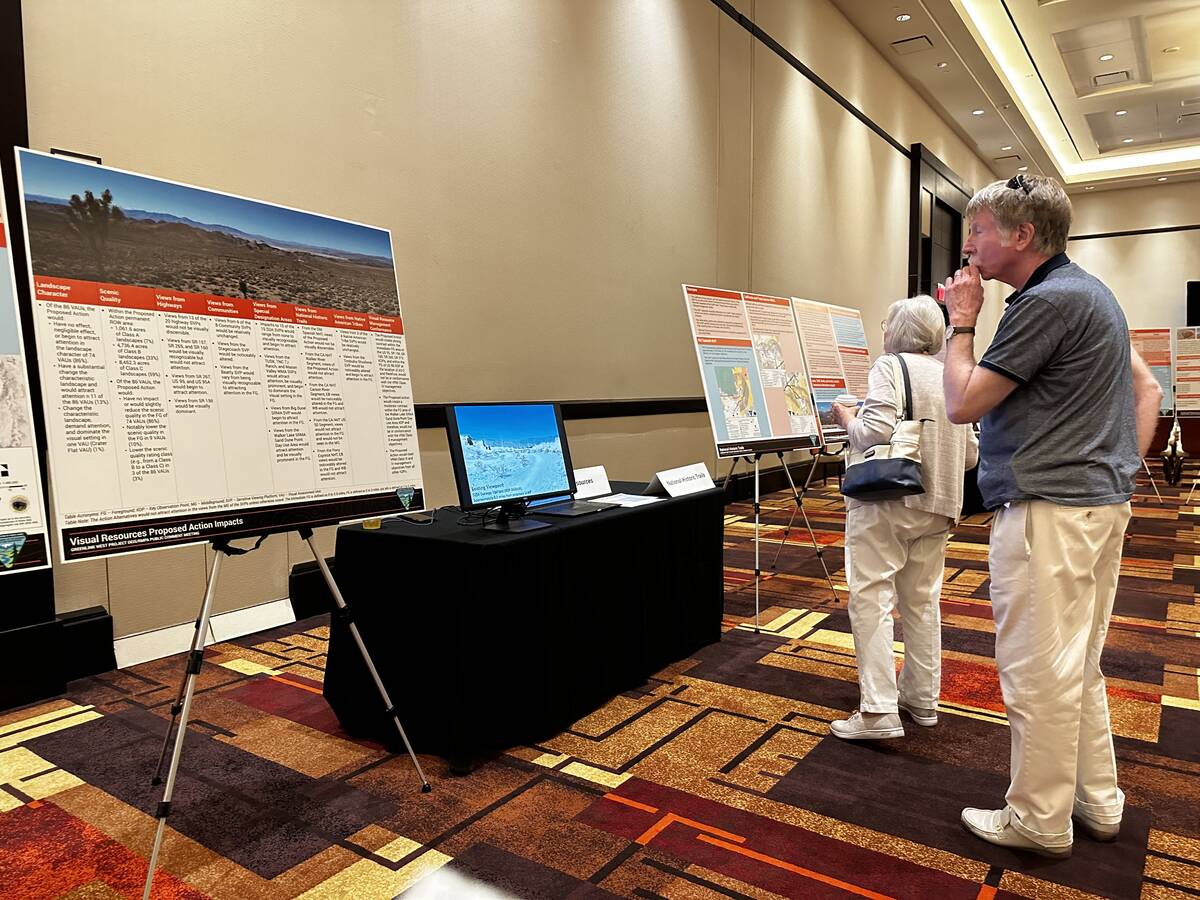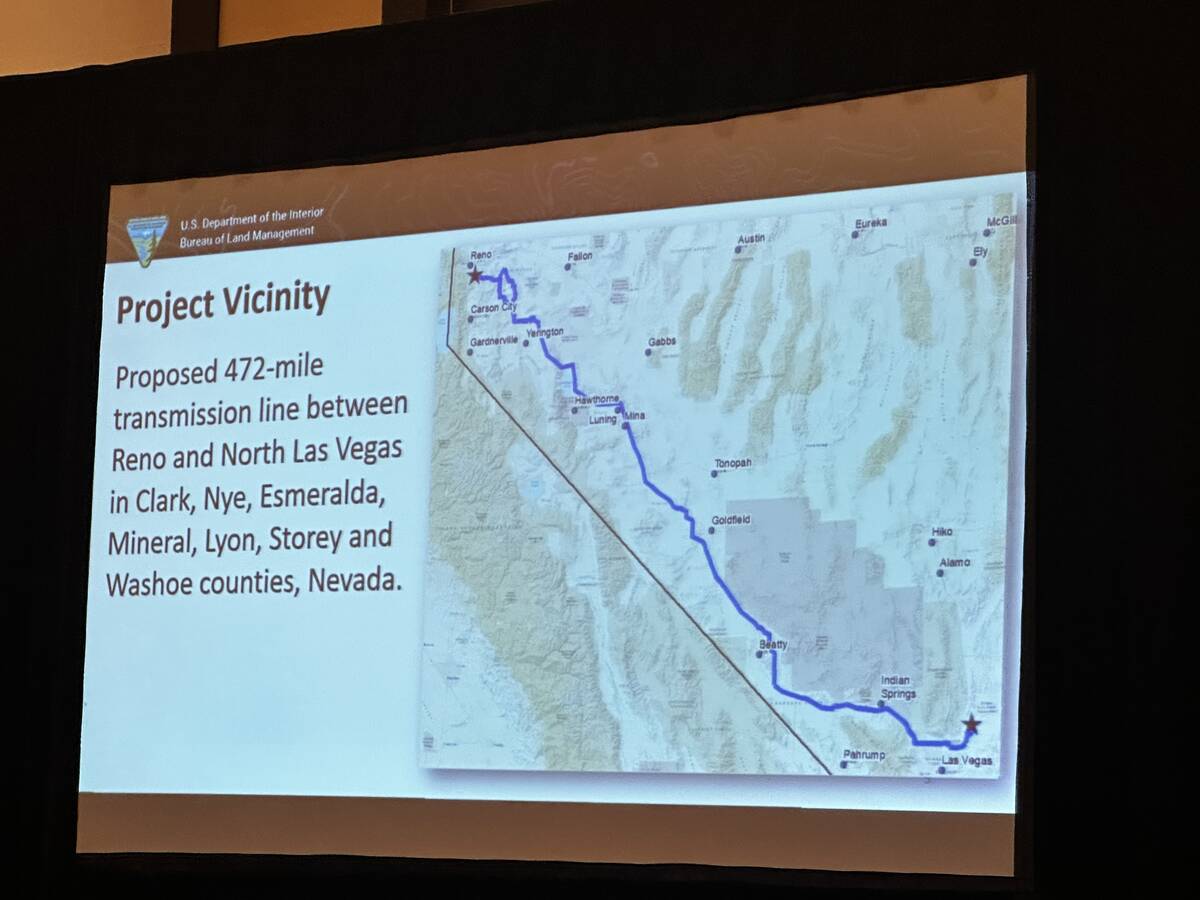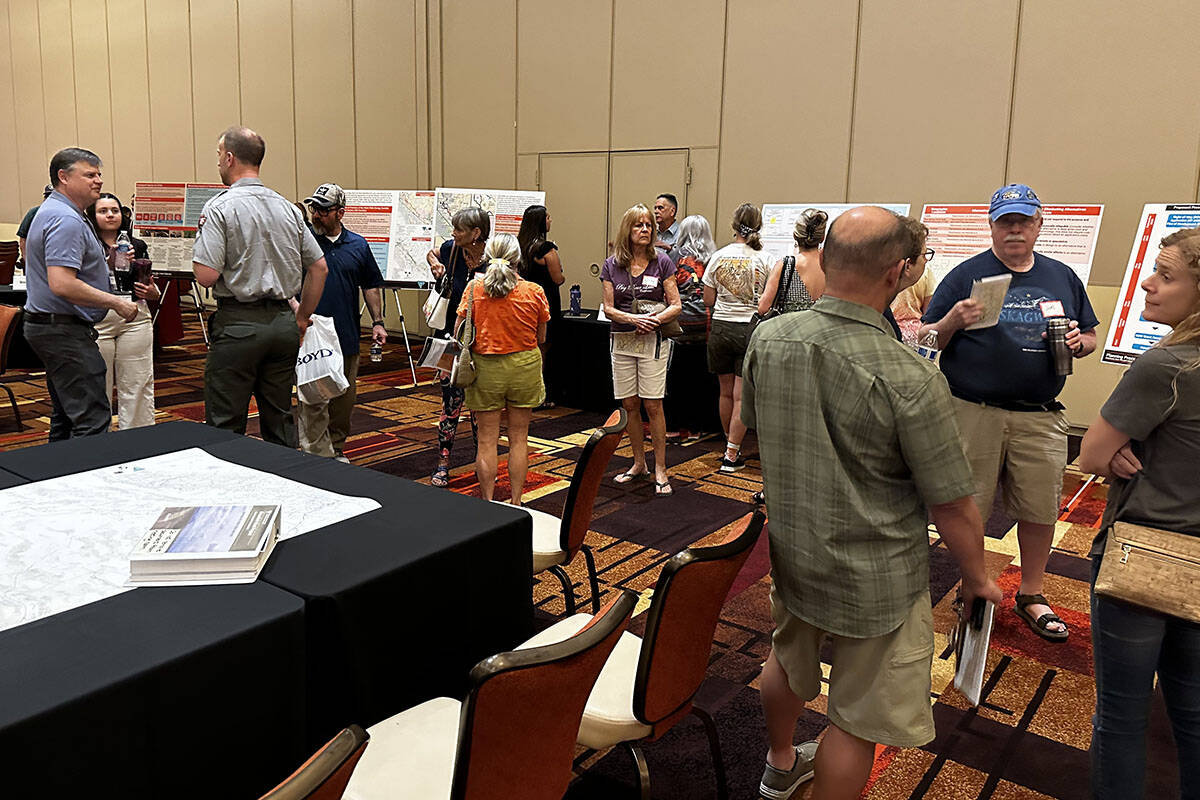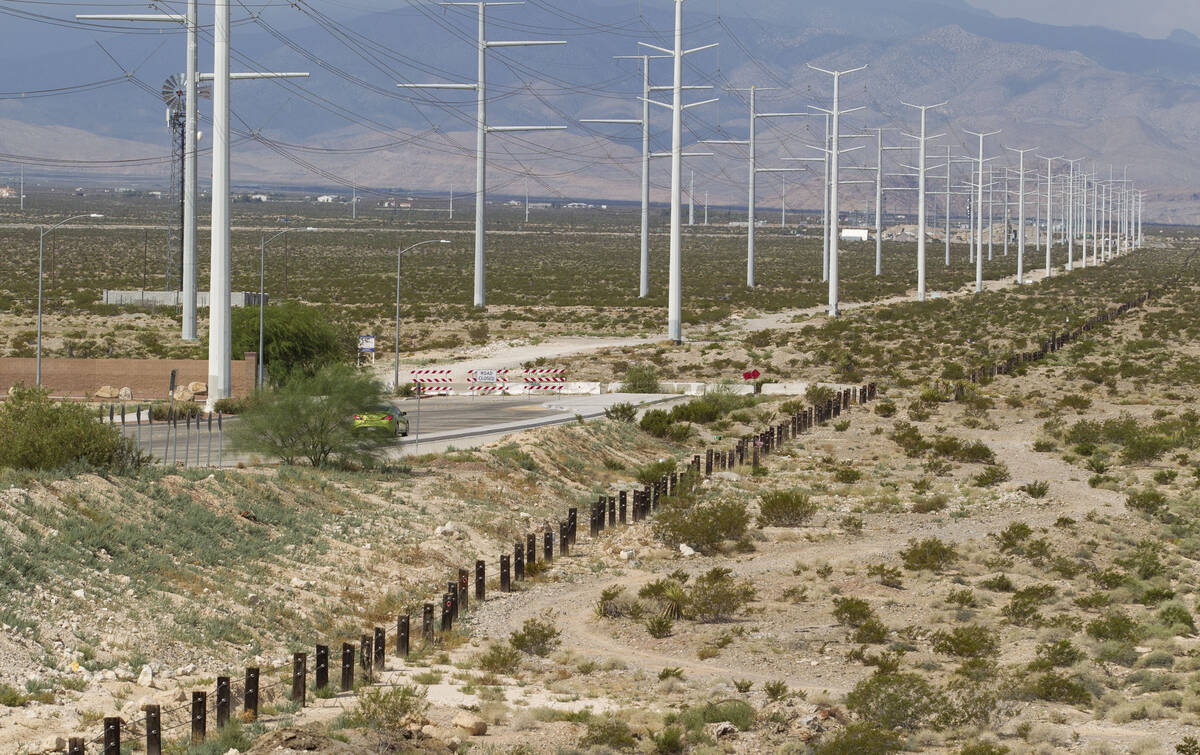‘Let’s not destroy another thing’: Tule Springs power line plan criticized
Potential impacts the construction of the multibillion-dollar Greenlink Nevada transmission line will have on a national monument and the desert ecoystems were the top concerns from the public at a Bureau of Land Management meeting held Tuesday night on the project.
As part of NV Energy’s proposed 472-mile Greenlink West Transmission line, BLM is considering placing 11 high-voltage electric poles (each 100 feet tall) inside the Tule Springs Fossil Beds National Monument, along the monument’s border with Moccasin Road. This is one of two transmission lines proposed to create the $2.5 billion Greenlink Nevada transmission line loop.
Many people who attended BLM’s scope meeting Tuesday evening at the Aliante Hotel in North Las Vegas pushed back against the idea of placing electric poles even an inch into the national monument.
“I don’t think it’s possible to go only 5 feet into the monument and not do any damage,” said Rita Ranson, a resident who advocated for the creation of the Tule Springs monument. “Stop and think of the equipment that will be doing the excavating for the pads on which the power poles will be placed.”
The national monument for Tule Springs was established in 2014 and covers 22,650 acres north of Las Vegas and was designated because of the large swath of fossils located in the area.
“It’s a national monument; let’s not destroy another thing,” Janelle Folkerts said during the meeting. “There is enough ugliness in the world. Let’s keep what we got people, let’s keep it pretty, let’s keep it for the kids and the grandkids.”
Greenlink West is the first phase of the Greenlink Nevada project which would add hundreds of miles of transmission lines to connect the three main population areas of the state — Reno, Ely and Las Vegas. NV Energy wants Greenlink West — the transmission line that would run between Las Vegas and Reno — to be finished by the end of 2026 and for the second phase called Greenlink North — the transmission line that would run from Ely to Reno — to be finished by the end of 2028. Advocates for Greenlink Nevada say building these transmission lines will make NV Energy’s grid more efficient and provide economic benefits.
The poles considered to be placed in Tule Springs would cover about 1½ miles of the Tule Springs area and be placed 5 feet into the national monument, Greg Helseth, the BLM’s Nevada branch chief for renewable energy, said. He defended potentially putting electric poles in the monument since it would be near existing roads and wouldn’t greatly impact the monument.
“We’re not destroying Tule Springs, we’re 5 feet into it,” he said. “We’ve done paleontological surveys, we’ve done cultural surveys, we’ve done plant surveys, we’ve done tortoise surveys. … We’re working with our partners here to make sure we’re going through the park permitting process properly.”
Most people weren’t satisfied with that argument and said no amount of land on Tule Springs should be disturbed.
“Can they guarantee that nothing would be destroyed?” local resident Paul Zwicker asked during the meeting. “If they cannot guarantee one bone will not be destroyed, then that is against the statute of a natural monument and another route should be considered.”
Most people who spoke against electric poles being placed in Tule Springs, though, were generally supportive of the Greenlink West project, which NV Energy has stated will help meet the state’s clean energy goals.
“Federal law has protected this land,” resident Wendy Dresser said. “We just want you to stay out, we’re not against you having poles just put them around.”
In an emailed statement, NV Energy said it appreciated BLM’s public process.
“Greenlink will allow NV Energy to meet future energy demands, leading to economic growth and job stability, and is essential to helping Nevada achieve its de-carbonization goals and increased renewable portfolio standard, moving Nevada closer to a future powered by 100 percent renewable energy and reducing our carbon footprint,” the statement said. The budget approved in 2020 by the Public Utilities Commission of Nevada (PUCN) for the Greenlink projects was approximately $2.5 billion. The company is making every and all efforts to mitigate any cost increases or schedule delays associated with inflation and supply chain issues that have arisen since the project budget and schedule was approved. The company will keep the PUCN and stakeholders informed as any changes are confirmed with final material and services costs.”
Desert concerns
Outside of the impact on the Tule Springs monument, concerns also were brought up by environmental advocates over Greenlink West’s potential to incentivize more renewable energy projects to be placed on desert land.
“We know that (Greenlink’s) purpose, it’s to open up remote parts of Nevada, which are not currently accessible for renewable energy development because there’s no transmission to develop (renewable projects),” said Patrick Donnelly, the Center for Biological Diversity’s Great Basin director, during the meeting.
Donnelly brought up the recent news of NV Energy spending $81.9 million at an auction to develop 7,000 acres of land in western Nevada to develop solar projects as an example of a desert area being taken up to develop solar.
Another concern was how the placement of energy projects in the desert of rural Nevada will permanently disrupt the ecosystem for energy used mostly in urban areas.
“It will open up all of western Nevada to renewable energy projects, which we think could be on rooftops and over solar parking lots,” said Laura Cunnigham, a co-founder of the environmental advocacy nonprofit Basin and Range Watch.
NV Energy has long stated that the proposed benefits of the Greenlink Nevada project will include more renewable energy to its system and allow the company to eventually rely entirely on renewable energy.
“(Greenlink Nevada) creates a renewable energy highway that allows access to Nevada’s resource-rich renewable energy zones, containing about 4,000 megawatts of undeveloped renewable resources, that could not previously be developed due to the lack of necessary transmission infrastructure,” stated NV Energy’s website on the Greenlink Nevada project.
The BLM will be taking comments on the Greenlink West project until Aug. 23 and is aiming to issue a decision on Greenlink West in 2024.
Contact Sean Hemmersmeier at shemmersmeier@reviewjournal.com or on Twitter @seanhemmers34.



